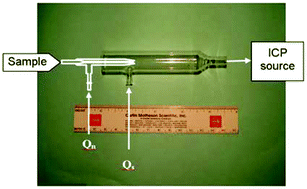In order to elucidate the absence of recondensation when using very low liquid delivery rates, the effect of flow rate of a sheathing gas injected in a single-pass spray chamber placed before the torch (i.e., cavity chamber) of an inductively coupled plasma atomic emission spectrometer (ICP-AES) on analytical performance and aerosol characteristics using analytical figures of merit was studied. Five different cavities of the so-called torch integrated sample introduction system (TISIS) were evaluated. Furthermore, two nebulizers were used: a PFA micronebulizer and a high efficiency nebulizer (HEN). A low inner volume cyclonic spray chamber (Cinnabar) was taken as the reference system. The studies were performed in terms of sensitivities, limits of detection and extent of the matrix effects and the elements evaluated were Al, As, Ba, Bi, Cd, Co, Cr, Cu, Fe, Hg, Mg, Mn, Ni, Pb, Sb, Se, Sr, V and Zn. The results indicated that the sheathing gas effect was dependent on the cavity inner volume as well as on the delivery liquid flow rate. For low liquid flow rates (i.e., 28 and 40 μl min−1) and long cavities, the increase in the sheathing gas flow rate caused an initial increase in the ICP-AES sensitivity and, then, a decrease. At higher liquid flow rates (i.e., 80 and 120 μl min−1) and for short spray chambers, an increase in the sheathing gas flow rate led to a decrease in the signal. These trends were explained in terms of the increased primary aerosol mean size (with Sauter mean diameters going from 8.2 to 17.0 μm as the nebulizer gas flow rate decreased from 0.8 to 0.2 l min−1) and reduced droplet inertial losses. The data obtained for the two nebulizers demonstrated that for the HEN, the effect of the sheathing gas was less significant than for the PFA. The TISIS cavities compared favourably with respect to the Cinnabar in terms of sensitivities. Long cavities gave rise to sensitivities up to 2.5 times higher than the Cinnabar. Matrix effects caused by inorganic (nitric acid) as well as organic (ethanol) concomitants were less pronounced for long than for short cavities for all the elements tested. The sheathing gas flow rate did not have a marked effect on the extent of the interferences.


 Please wait while we load your content...
Please wait while we load your content...